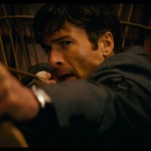Odds And Ends
My starter post for this week’s What Are You Playing This Weekend? thread discussed a pretty neat fan game I’ve been toying around with that reimagines the original Castlevania as a first-person shooter in the Doom engine. DL left a great comment that points out a meta layer that makes it even more fascinating proposition:
This Castlevania mod is an excellent illustration of how our copyright laws are used. First, we have id Software releasing the engine behind Doom to the public domain, giving anyone the freedom to build their own creative works based on theirs. It’s a great way to promote creativity, something copyrights themselves are supposed to foster through protection of works but while limiting the protection to a reasonable time frame. On the other hand, we have the Castlevania assets, which are being used here in violation of copyright, despite the game being a human-generation old. Konami could use those copied assets as a reason to send lawyers the creator’s way, despite it being given away for free, which could be argued devalues the assets Konami has a right to sell.
What we are left with is a letter of a law and the implementation of it contrasting greatly and widely variable. There’s no way for Andrea Gori to know if or when any action could be taken against him, and if nothing comes of it, it doesn’t prevent any future action from being taken against someone else. Our copyright laws have limited so much creative material from being placed into the public domain that we are starting to see the pendulum swing back where assets are simply given out (thanks Creative Commons) or not pursued because of an overabundance of assets that lack sufficient value, or allowed to foster quietly in the background of society until “release,” like AM2R. Nintendo followed the letter of the law in their copyright but allowed the spirit of creativity to grow so Milton Guasti could show his talent and use it to find a job in the games industry. Maybe we can use this growing mindset to find a better balance to the laws. I think the only thing that will change is there will be two tiers of copyright: corporate assets that are immutable and owned forever, and “folk art” that gets shared, expanded, and improved. Who needs Mickey Mouse when we have trollface…wait, bad example…or maybe that’s a perfect one.
Elsewhere in the weekly thread, The Demons continued their fantastic, weekly look at a very interesting personal project involving Magic: The Gathering, where they use the stories and cards of each new set to build decks that are designed to go up against one another. I’ll provide an excerpt from this week’s post, but you can, and should, find the first of The Demons’ meaty, illustrated rundowns here:
One of the keys to the longevity of Magic: The Gathering is that it can tell so many stories. The fundamentals of the fantasy battle the card game depicts may stay the same, but the context of the conflict—who is fighting, where, over what—is different every time. One year the players are depicted as agents of the syndicates jockeying for position in a megalopolis, the next they’re depicted as survivors in post-apocalyptic wasteland. The game uses a multiverse of possibly infinite worlds, and switching up the tropes makes each set feel fresh.
There’s a world whose components come to life, as animate avatars of earth, air, water or fire, to attack those it perceives as “trespassing.” There’s a world ruled by a pantheon of gods who draw their power from mortal worship. There’s a world where mana is not so much channeled through casters as it is harnessed by industry to run a variety of wondrous machines. No matter where you are, the only metaphysical constant is that there are five types of mana (not counting colorless, which is usually dismissed as diluted or artificial), each of which is a fuel that powers a type of magic, and the people who master one or more of these magicks are the people with power and agency.
Shards Of Alara, from 2008, is the Magic set I’m talking about this week. There have been other sets I could summarize as “feudal japan world” and “gothic horror world,” and those would be examples of top-down design, where they start with the style and mood they’re trying to capture, and adapt the source material to Magic’s 5-color structure. Shards Of Alara, however, is bottom-up design, where the mechanics came first, and the story was written around the structure of gameplay.
The Demons goes on to break down the new rules introduced in this set and then provide the decks and game they’ve built around it. This is some fascinating stuff, and I hope to see more!
That’ll do it for this week, Gameologicrats. As always, thank you for reading and commenting. We’ll see you next week!







































